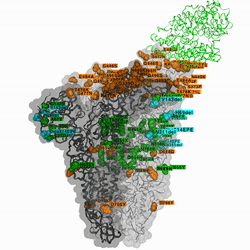Some media outlets warn that those who have previously had coronavirus have a higher risk of becoming infected with the new variant of the virus. We decided to check whether this corresponds to scientific data.
Released with appropriate headlines "Parliamentary newspaper" (“The WHO warned those who have recovered from COVID-19 about the high risk of becoming infected with Omicron”), Lenta.ru (“WHO warned COVID-19 survivors about possible infection with the Omicron strain”), “RIA Novosti"(WHO stated that those who have recovered from COVID-19 can become infected with the Omicron strain"), "Rossiyskaya Gazeta" (“WHO: Those who have recovered from COVID-19 may become more easily infected with omicron”), etc.
Option "Omicron" (why this option and not the strain, you can read in our other analysis) - B.1.1.529 - registered at the end of November in the south of the African continent. Just two days later, WHO convened meeting at which it assigned a letter of the Greek alphabet and classified it immediately as a variant of concern, along with already famous "Alpha", "Beta", "Gamma" and "Delta". Variants of concern have “genomic changes that are predicted or confirmed to lead to changes in characteristics of the virus, such as transmissibility, the severity of the disease caused by the virus, the ability to evade the immune response, diagnostics or drugs.” They are also capable of “causing intense community transmission or the emergence of multiple COVID-19 clusters in multiple countries, accompanied by an increase in the relative prevalence and number of cases of the disease, or other clear signs of an epidemiological impact indicating the emergence of a new source of risk to public health worldwide.”
The Omicron variant has been completely sequenced, that is, its amino acid or nucleotide sequence has been determined. On the Outbreak.Info website, which visualizes data from the GISAID database - a library of genomic data of viruses, reflectedthat it has at least 45 significant differences from previous variants, of which 26 mutations (changes) and three deletions (loss of a region) occur in the S protein, on recognition on which many of the existing vaccines are based. Mutations are designated by a “letter-numbers-letter” code, the number in which indicates the position in which the change occurred, the first letter indicates the amino acid that was in that position before, and the second indicates the amino acid that is in the new version. Deletions are designated by the letters DEL and a pair of numbers that indicate the “coordinates” of the dropped fragment.

At the same time, it takes less time to determine which elements have changed to which ones than to reliably correlate changes in the genome with their effect on characteristics. So scientists are still figuring out in detail what new properties of the variant are encoded in these changes. Moreover, the very presence of so many changes clearly indicates that the Omicron S-protein looks significantly different than the S-protein of other variants, for example, “Delta” or the original Wuhan one. Mechanism protection against the virus works as follows: antibodies that arise after vaccination or illness, have “photo identikit” of a fragment or the virus as a whole, they compare the pathogen entering the body with it and, if recognized, activate the immune response. The fact that the S-protein and other parts of the virus have changed greatly leads to the fact that antibodies have a higher chance of “not recognizing” them by sight and not giving the body an alarm command.

This is exactly what WHO warns about in its press release. Let's quote organization verbatim: “Preliminary data, although limited, indicate that, compared with other variants of concern, the Omicron variant may increase the risk of reinfection.” The media missed an important part of this phrase, creating the impression that those who have been ill are, in principle, more susceptible to recurrent illness than those who have not been ill, and not that their risk of contracting Omicron after Delta is higher than, say, the probability of catching Iota after Delta or Mu after Alpha.
However, it is worth noting that of the media cited above, some indicated this information further in the text. Rossiyskaya Gazeta noted this in the second paragraph, Parlamentskaya Gazeta and Lenta.ru in the third, while RIA Novosti completely bypassed this detail.
Regarding the effectiveness of vaccines against the new variant WHO is quite optimistic: “Currently used vaccines continue to effectively protect against severe disease and death from it.” At the same time, the organization notes that additional research will be conducted regarding vaccines. Center named after Gamaleya has already started adaptation of the Sputnik V and Sputnik Light vaccines to Omicron, however, stipulating that the current version also has a high potential for neutralizing the variant.
Thus, with their headlines, and sometimes entire articles, the media misled readers regarding the position of the WHO and the likelihood of infection with a new variant for those who had already been ill before.

Not true
Read on the topic:
- Vodovozov about Omicron | The task of any virus is to multiply and capture more new hosts
- Viral update: why it’s too early to be afraid of the Omicron strain
If you find a spelling or grammatical error, please let us know by highlighting the error text and clicking Ctrl+Enter.






